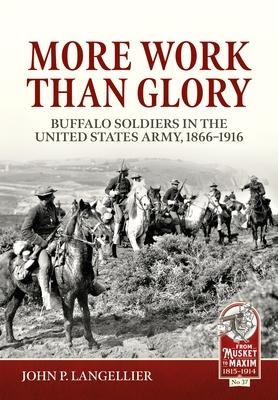
Book
More Work Than Glory: Buffalo Soldiers in the United States Army, 1866-1916
(Write a Review)
Paperback
$49.95
"...an invaluable read, not only for those with an interest in the Black regulars, but also for those seeking to learn more about the Army from the Civil War through the Great War." -- The NYMAS Review
Prior to the 1960s, the term "Buffalo Soldier" was a fairly obscure one. Then, a trickle of titles became a torrent of books, articles, novels, monuments, and expanding numbers of historic sites along with museums all of which have changed the picture. Even an occasional nod from television and movies helped transform these once relatively little-known Black U.S. Army troops into familiar figures, who have taken their place in a mythic past. Indeed, powerful imagemakers from William F. "Buffalo Bill" Cody and his Congress of Rough Riders to Frederic Remington, the dean of frontier artists, helped lionize the Black troops whose exploits brought them to the American West, Cuba, the Philippines, Mexico, Alaska, and Hawaii in the years between 1866 and 1916.
Despite a significant shift in emphasis, numerous efforts treating this element of the vital, complex story of the post-Civil War U.S. Army frequently repeated earlier studies rather than added fresh perspectives. Also, the narrative typically ended with the so-called Indian Wars or Spanish American War. Many authors likewise dwelt on military operations rather than numerous other relevant contributions and activities of these men who played a role in the nation's complex evolution during the half century after the American Civil War.
Profusely illustrated with compelling images and detailed maps, along with an array of appendices, this latest addition to the Buffalo Soldier saga represents over five decades of research by military historian John P. Langellier. Further, More Work an Glory: Buffalo Soldiers in the United States Army, 1866-1916 combines the best features of prior scholarship while enhancing the scope with new or underused primary sources.
The author views the subject through the broader perspectives of race. He sets the text against the backdrop of the transition of the U.S. Army from a frontier constabulary to an international power. In the process, he highlights the staggering assortment of non-military missions including assignments to national parks and forests; road building; exploration; pioneer military bicycling; duty along the explosive border between the United States and Mexico; employment as agents of law and order, along with a litany of other contributions that enhanced an impressive combat record against formidable Native Americans and others. Langellier frames the narrative within the context of continuity and change from Reconstruction in the 1860s through the early twentieth century. Above all, he focuses on the soldiers themselves to provide a human perspective as well as challenges prevalent misconceptions that often overshadow more fascinating facts.
"...an invaluable read, not only for those with an interest in the Black regulars, but also for those seeking to learn more about the Army from the Civil War through the Great War." -- The NYMAS Review
Prior to the 1960s, the term "Buffalo Soldier" was a fairly obscure one. Then, a trickle of titles became a torrent of books, articles, novels, monuments, and expanding numbers of historic sites along with museums all of which have changed the picture. Even an occasional nod from television and movies helped transform these once relatively little-known Black U.S. Army troops into familiar figures, who have taken their place in a mythic past. Indeed, powerful imagemakers from William F. "Buffalo Bill" Cody and his Congress of Rough Riders to Frederic Remington, the dean of frontier artists, helped lionize the Black troops whose exploits brought them to the American West, Cuba, the Philippines, Mexico, Alaska, and Hawaii in the years between 1866 and 1916.
Despite a significant shift in emphasis, numerous efforts treating this element of the vital, complex story of the post-Civil War U.S. Army frequently repeated earlier studies rather than added fresh perspectives. Also, the narrative typically ended with the so-called Indian Wars or Spanish American War. Many authors likewise dwelt on military operations rather than numerous other relevant contributions and activities of these men who played a role in the nation's complex evolution during the half century after the American Civil War.
Profusely illustrated with compelling images and detailed maps, along with an array of appendices, this latest addition to the Buffalo Soldier saga represents over five decades of research by military historian John P. Langellier. Further, More Work an Glory: Buffalo Soldiers in the United States Army, 1866-1916 combines the best features of prior scholarship while enhancing the scope with new or underused primary sources.
The author views the subject through the broader perspectives of race. He sets the text against the backdrop of the transition of the U.S. Army from a frontier constabulary to an international power. In the process, he highlights the staggering assortment of non-military missions including assignments to national parks and forests; road building; exploration; pioneer military bicycling; duty along the explosive border between the United States and Mexico; employment as agents of law and order, along with a litany of other contributions that enhanced an impressive combat record against formidable Native Americans and others. Langellier frames the narrative within the context of continuity and change from Reconstruction in the 1860s through the early twentieth century. Above all, he focuses on the soldiers themselves to provide a human perspective as well as challenges prevalent misconceptions that often overshadow more fascinating facts.
Paperback
$49.95